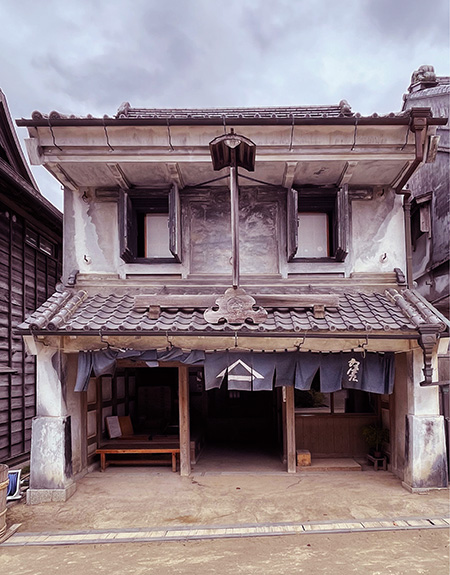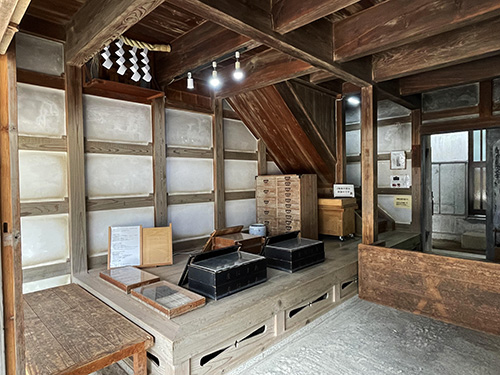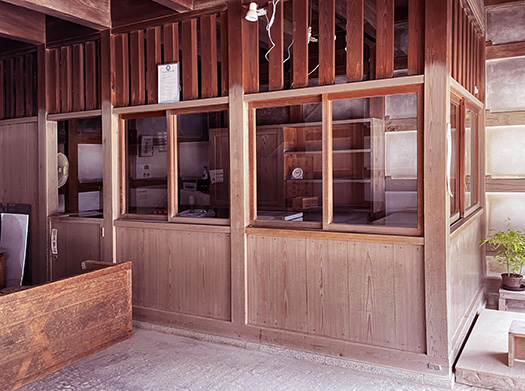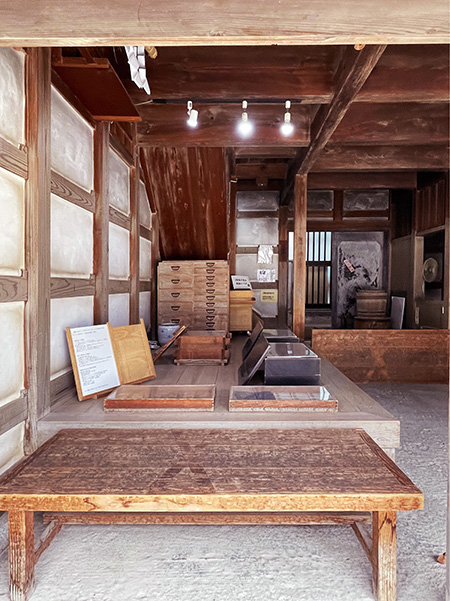

日本の街の成立は、農業を基盤としたムラの境界の道に沿って出来上がっていったと言われる。生産手段であり、生き延びていく基本である農的生活のなかで非日常の点景として出現したのだろう。農業生産生活・暮らしに不可欠な職人仕事などがきらびやかに示された。
そういう町家店舗のなかでも甘味を売る店は、格段の集客力を持っていたに違いない。日本人の味覚としての甘みというのはきわめて貴重なものであり、それがわかりやすい店舗として具現化していることはそこにキラキラした世界の明確な入口として示されていたのだろう。しかしそれは法事や特殊な行事を飾る非日常感の象徴でもあったように思われる。日本史でも特権階級であったり、寺院での嗜好品としてきわめて特殊な存在だったとされている。江戸期のような大衆社会化状況が盛り上がりがあって、こういうふうに「大衆化」してきたものだろうと思う。
それでも砂糖は長崎からの海外交易で輸入され続けてきたものであり、その流通も含めて特殊な権益構造によって社会的に維持されてきた。需要は十分に予測可能だけれど総量規制されたようなマーケットであり、資本主義的な需要と供給の自由な交易が十分ではない社会の中で、特殊に存在してきた。


菓子屋は朝が早い。「朝ナマ」といわれる大福・団子・饅頭などは、朝のうちに作る。これは必ずその日のうちに売り切るべき日持ちのしない菓子。朝ナマを作り終わって一息つくと、干菓子や飴などにとりかかりる。練切などは集中力が必要なため、夜に作る場合もあった。概して寒い時期に忙しく夏は菓子が売れなくなる。人生儀礼や年中行事に結び付いた需要が多く冠婚葬祭の引き出物、初節句や七五三の配り菓子などを頼まれると、徹夜となることさえあったという。
寺社の門前で参詣客に土産の菓子を売る菓子屋には安定した売り上げがあった。寺の得意となってお供物の菓子を納める場合もあり、祭りに特別な注文が入ることもあったことから、菓子屋にとって寺社はないがしろにできない存在だった。
店舗建築としては店頭で製造工程そのものを展示するスタイル。明治以降は「ガラス建材」で仕切りを作って清潔を維持したことだろう。菓子箪笥が階段下にあるけれどここには干菓子を入ている。菓子が湿気ないように桐製だという。菓子箱には大福やきんつば、羊羹、しおがま、おこしなどが入れられ赤い漆塗りで粉がしかれて商品管理されていた。せいろには湿度管理が大切な小麦まんじゅうが入っている。日本人のライフスタイルとしての甘味と暮らしの関係を想起させる店舗建築。
English version⬇
The star attraction of the townscape “Sweet store”-2 Edo Period, Boso Machiya-9
The largest star store in the group of machiya stores. It was an industry that regulated the total amount of its material “sugar”. The function of decorating the “Hare” (ceremonial occasions) of weddings and funerals. ・・・・.
It is said that Japanese towns were established along the boundary paths between villages based on agriculture. They probably emerged as an extraordinary landscape in the midst of agricultural life, which is the means of production and the basis of survival. The artisans’ work, which is essential to agricultural production and daily life, was displayed in a glittering manner.
Among these machiya stores, those that sold sweet foods must have had an exceptional ability to attract customers. Sweetness is an extremely precious part of the Japanese palate, and the fact that it was embodied in a store that was easy to understand must have been a clear gateway to the glittering world of sweetness. However, it also seems to have been a symbol of the extraordinary sense of decorating for legal and special events. In Japanese history, it is said to have been a very special item for the privileged classes and as a luxury item in temples. I believe that it became “popular” in this way when the mass socialization of the Edo period was in full swing.
Even so, sugar has continued to be imported through overseas trade from Nagasaki and has been socially maintained by a special interest structure that includes its distribution. It is a market where demand is sufficiently predictable but the total quantity is regulated, and it has existed uniquely in a society where free trade between capitalist supply and demand is not sufficient.
Confectioners are early in the morning. Daifuku, dango, and manju (steamed buns), known as “asanama,” are made in the morning. These are sweets that do not last long and must be sold out by the end of the day. After finishing the “morning nama,” they take a break and start working on dried confections and candies. Nerikiri, for example, required a lot of concentration, so it was sometimes made at night. Generally, they were busy during the cold season, and sales of confections were slow during the summer. Many of the confections were related to life ceremonies and annual events, and when asked to make gifts for weddings and funerals, or confections to be given out on New Year’s festivals and the 75th and 75th birthdays, the confectioners even had to stay up all night.
Confectionery shops selling souvenirs to visitors at the gates of temples and shrines enjoyed steady sales. They sometimes became the specialty of temples and delivered sweets as offerings, and they sometimes received special orders for festivals, so temples and shrines were an existence that confectionery shops could not ignore.
The style of store architecture was to display the manufacturing process itself in the storefront. After the Meiji period, partitions would have been made with “glass building materials” to maintain cleanliness. A chest of confectionery is located under the stairs and used to store dried confections. They are said to be made of paulownia wood to prevent the sweets from getting damp. Daifuku, kintsuba, yokan jelly, shiogama, okoshi, etc. were stored in confectionery boxes, which were lacquered in red lacquer and covered with powder to keep them in good condition. In the “Sei” box, there are wheat manjus (wheat buns), for which humidity control is very important. The store’s architecture evokes the relationship between sweetness and daily life as part of the Japanese lifestyle.
Posted on 1月 16th, 2023 by 三木 奎吾
Filed under: 住宅マーケティング, 日本社会・文化研究







コメントを投稿
「※誹謗中傷や、悪意のある書き込み、営利目的などのコメントを防ぐために、投稿された全てのコメントは一時的に保留されますのでご了承ください。」
You must be logged in to post a comment.